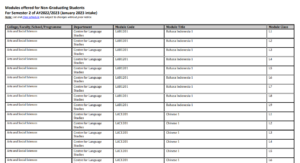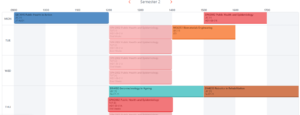Hi there! Hope things are going well on your end. If you are reading this, it means that you have (1) considered applying for SUSEP OR (2) already been offered a slot to study at the National University of Singapore (NUS). It doesn’t make a difference if you are at stage (1) or (2) since both of them involve similar preparations. I hope this guide will be useful for you!

Step 1: Understanding yourself
- Which pillar are you in? Which track are you in? I am in Engineering Product Development (EPD) and a part of the Healthcare Engineering Track (HED).
- What are your pillar and track requirements? How many unrestricted modules can I take? Given my pillar and track, I am actually required to take certain core modules like 30.203 Topics in Biomedical and Healthcare Engineering (Term 6) and 30.123 Healthcare Product Design (Term 7). I was also allowed to take only 3 unrestricted modules over the course of my entire SUTD studies.
- What should I find out before starting my study plan? You should find out
- Which core module do you have to clear for your track?
- What are some pillar electives/modules (i.e. those that are NOT unrestricted) that you would like to take in Term 7 and 8? Do they have prerequisites? If you are interested to take them and they have prerequisites, do prioritize these pre-requisite modules in your SUSEP.
- What are some unrestricted modules you would like to take when you are back in SUTD and how many do you plan to take? If you would like to take a total of 2 unrestricted modules in Term 7 and 8, then you can try taking 1 unrestricted module in NUS.

Step 2: Study Plan and how to “Troubleshoot”
The study plan is important for you to let the school know what courses you are interested in and how you can map the NUS courses to SUTD ones. Here are some tips for the study plan that I thought would be good for you to know:
- Check NUS website to see if they have released the latest Module List for non-graduating students. Note that I am talking about the module list for the semester that you will enter NUS! E.g. If you are entering NUS in January-April, it will be Semester 2!
- [Troubleshoot] If not, ask the school (SUTD Global Office or NUS NG Office) for the previous year’s module list. Disclaimer: The modules offered to NG like yourself might change every year but try your best to map as many modules as possible
- For my batch, the latest module list was only released in late August, which was 2 weeks after our SUTD SUSEP application
- Map as many modules as possible. Feel free to exceed the school’s recommendation (8 Pillar + 2 HASS modules). This is to ensure that you have enough safety net because (1) the modules list might not be entirely accurate (e.g. there are modules in the NG list that may not actually be offered to NG) (2) There might not be vacancies any more and you may be forced choose other options.
- Prioritize the mapping of core modules and pillar-electives
- You are usually allowed to map Term 7 and 8 modules too! They shouldn’t affect your UE quota too (but do seek confirmation from your pillar manager).
- You can actually choose modules that aren’t offered in SUTD but are relevant to your pillar! However, they will be considered unrestricted modules.
- E.g. For EPD, you can map the NUS module to the SUTD unrestricted module (usually named as 30.XXX in SUTD’s application/admission portal)
- [For those without HASS minor] However, for HASS, feel free to pick relevant modules as there are no restrictions on the number of unrestricted modules that you can take for HASS. I have friends taking language modules, while I took public health modules as I am very interested in healthcare!
- Before the deadline for study plan submission, save all your updates as drafts, and DO NOT submit them.
- I submitted them very early on by accident and had to go through cumbersome administrative hassles that I believe you wouldn’t want to go through! Once you submit your study plan, you will not be allowed to edit it.
- [Troubleshoot] If you have accidentally submitted your study plan and you need to update the school on important changes, download the Transfer Credit Form and fill them in a PDF format. Send it to the Global Office and your pillar manager as soon as possible.
- [Troubleshoot] If there aren’t any updates regarding the approval of your course mapping, you may want to reach out to Prof (that is leading the course you are mapping to) politely and ask if they approve the mapping. If an approval is given, do update the pillar manager.


Step 3: Narrowing your Study Plan
When it’s time to submit your SUSEP application to NUS (i.e. NUS will open a portal for you to apply for the exchange and do take note of the strict deadline!), you will be required to submit and rank your modules choices.
- Decide on whether you want to take 3 Pillar + 2 HASS or 4 Pillar + 1 HASS
- Given that there aren’t restrictions to the number of unrestricted HASS modules you can take and the hassle of mapping pillar-specific modules, the 3 Pillar + 2 HASS option is usually favored
- Pick your top 10 modules (including the 3 Pillar + 2 HASS or 4 Pillar + 1 HASS)
- During the NUS SUSEP application, you will be asked to pick and rank 10 NUS modules, all of which will be subjected to approval.
- Rank them wisely, prioritizing the core modules that you have to take!
- Unlike SUTD where modules are allocated on a first-come-first-serve basis, modules in NUS are allocated based on factors such as the ranking of the module, your major/track, and seniority
- Note that modules with no exams (yes, there are modules with no exams) are usually the more popular ones
- On https://nusmods.com/, find out the timetable of the modules that you have selected and try out the different combinations
- The onus is on you to ensure that there are no clashes in your timetable!
- Some NUS modules have tutorials that have different timeslots that you are able to choose from. Play around with the tutorial timeslot to find out which one suits you! Open your planned calendar and hover around the boxes. If the box becomes darker, click on it and see what are tutorial timeslots available. [See Figure 2a-2c below]
- NUS will arrange a day for you to list and rank your preferred timeslot, which is subjected to availability.
- Lecture time was pre-allocated for me, hence, I was not able to choose.
- During the NUS SUSEP application, you will be asked to pick and rank 10 NUS modules, all of which will be subjected to approval.





Step 4: Pre-allocated Modules, ModReg and Appeal
The pre-allocation results will be released and most people I knew got 2-4 modules secured only. You must be very worried since you need 5 modules right?

Fret not! The pre-allocation exercise is not the end of the world as there are two channels for you to try to get into your chosen courses.
- Mod-Reg: Similar to the pre-allocation exercise, it is not first-come-first-serve and you have to list and rank your choices.
- For my batch, we only had one Mod-Reg exercise for NG!
- A vacancy report (https://www.nus.edu.sg/modreg/resources.html) will be available close to the date of your ModReg where you can check out the number of slots left for the modules that you want to take.
- [Troubleshoot] Not able to find your module in the ModReg exercise although it is inside the list of modules offered to NG? Appeal for your module under the “Issues while selecting module” category.
- Appeal
- If your Mod-Reg results are unsuccessful, you can still appeal. If there isn’t much progress on the appeal or urgent matters that you have to address, you can reach out to the host department’s manager (https://www.nus.edu.sg/ModReg/docs/UGFac_Contacts.pdf), who will be processing your appeal, via email. Remember to provide your NUS Student ID to them and be polite!
- NUS has specific timelines for the different types of appeal. Do check out the appeal timetable/schedule here https://www.nus.edu.sg/modreg/schedule-and-timeline.html and mark the dates on your calendar!
- Do note that appeal still happens during Weeks 1 and 2 of school, where some of your peers may drop modules.

Summary of NUS SUSEP Application Process
Application Process (in order)
- SUTD SUSEP Application + Submission of Study Plan 1
- Interview
- Submission of Study Plan 2
- NUS SUSEP Application + Module Selection
- Results for module pre-allocation
- ModReg
- Appeal
Important links:
- NUS Mod (To find out more about NUS modules and their schedule + Information required for credit transfer form): https://nusmods.com/
- NUS Vacancy Report (To find out number of slots are left you the modules you want): https://www.nus.edu.sg/modreg/resources.html
- NUS ModReg and Appeal Timeline (To find out important dates): https://www.nus.edu.sg/modreg/schedule-and-timeline.html
- Host Department Contact (that you may need to contact regarding your appeal or ModReg): https://www.nus.edu.sg/ModReg/docs/UGFac_Contacts.pdf

Conclusion
Hopefully I managed to cover all the burning questions that you may have during your NUS SUSEP application! It will definitely not an easy one but it will be worthwhile. I was also very lost during the whole process as there were a lot of areas that lacked clarity and there wasn’t much information on EPD students going SUSEP. Nonetheless, I was able to refer to my senior’s post/tips here on WeAreSUTD, which helped me immensely. Feel free to check out the following posts by our seniors
Choosing NUS Modules by Arissa
My onboarding experience at NUS (with some ModReg tips!) by Chee Kit Chong

































